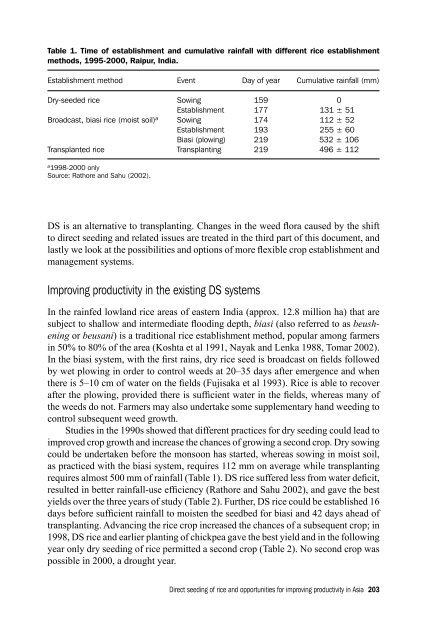Download (2461kB) - University of Greenwich
Download (2461kB) - University of Greenwich
Download (2461kB) - University of Greenwich
- No tags were found...
You also want an ePaper? Increase the reach of your titles
YUMPU automatically turns print PDFs into web optimized ePapers that Google loves.
Table 1. Time <strong>of</strong> establishment and cumulative rainfall with different rice establishmentmethods, 1995-2000, Raipur, India.Establishment method Event Day <strong>of</strong> year Cumulative rainfall (mm)Dry-seeded rice Sowing 159 0Establishment 177 131 ± 51Broadcast, biasi rice (moist soil) a Sowing 174 112 ± 52Establishment 193 255 ± 60Biasi (plowing) 219 532 ± 106Transplanted rice Transplanting 219 496 ± 112a 1998-2000 onlySource: Rathore and Sahu (2002).DS is an alternative to transplanting. Changes in the weed flora caused by the shiftto direct seeding and related issues are treated in the third part <strong>of</strong> this document, andlastly we look at the possibilities and options <strong>of</strong> more flexible crop establishment andmanagement systems.Improving productivity in the existing DS systemsIn the rainfed lowland rice areas <strong>of</strong> eastern India (approx. 12.8 million ha) that aresubject to shallow and intermediate flooding depth, biasi (also referred to as beusheningor beusani) is a traditional rice establishment method, popular among farmersin 50% to 80% <strong>of</strong> the area (Koshta et al 1991, Nayak and Lenka 1988, Tomar 2002).In the biasi system, with the first rains, dry rice seed is broadcast on fields followedby wet plowing in order to control weeds at 20–35 days after emergence and whenthere is 5–10 cm <strong>of</strong> water on the fields (Fujisaka et al 1993). Rice is able to recoverafter the plowing, provided there is sufficient water in the fields, whereas many <strong>of</strong>the weeds do not. Farmers may also undertake some supplementary hand weeding tocontrol subsequent weed growth.Studies in the 1990s showed that different practices for dry seeding could lead toimproved crop growth and increase the chances <strong>of</strong> growing a second crop. Dry sowingcould be undertaken before the monsoon has started, whereas sowing in moist soil,as practiced with the biasi system, requires 112 mm on average while transplantingrequires almost 500 mm <strong>of</strong> rainfall (Table 1). DS rice suffered less from water deficit,resulted in better rainfall-use efficiency (Rathore and Sahu 2002), and gave the bestyields over the three years <strong>of</strong> study (Table 2). Further, DS rice could be established 16days before sufficient rainfall to moisten the seedbed for biasi and 42 days ahead <strong>of</strong>transplanting. Advancing the rice crop increased the chances <strong>of</strong> a subsequent crop; in1998, DS rice and earlier planting <strong>of</strong> chickpea gave the best yield and in the followingyear only dry seeding <strong>of</strong> rice permitted a second crop (Table 2). No second crop waspossible in 2000, a drought year.Direct seeding <strong>of</strong> rice and opportunities for improving productivity in Asia 203
















